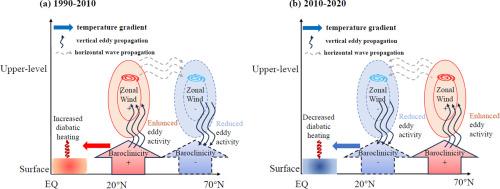A reversal of upper-air wind speed in the Northern Hemisphere
IF 3.2
4区 地球科学
Q3 METEOROLOGY & ATMOSPHERIC SCIENCES
引用次数: 0
Abstract
Previous studies have indicated a global reversal of near-surface wind speeds from a declining trend to an increasing trend around 2010; however, it remains unclear whether upper-air wind speeds exhibit a similar reversal. This study evaluates reanalysis products using surface and radiosonde observations to analyze upper-air wind speed variations in the Northern Hemisphere, focusing on their seasonal and latitudinal differences. Results demonstrate that JRA-55 effectively captures wind speed variations in the Northern Hemisphere. Notably, upper-air wind speeds over land experienced a reversal in winter 2010 with significant latitudinal differences. The trend reversal of upper wind speed between the midlatitudes and subtropics presents a dipole pattern. From 1990 to 2010, upper-air wind speeds in the midlatitudes (40°–70°N) significantly declined, while the subtropical zone (20°–40°N) displayed an opposite trend. However, during 2010–2020, wind speeds in the midlatitudes shifted to a significant positive trend, whereas the subtropics experienced a significant negative trend. The variations in Northern Hemisphere winter wind speeds can be attributed to changes in low-level baroclinicity driven by tropical diabatic heating and midlatitude transient eddy feedback. Enhanced diabatic heating and weakened eddy feedback during 1990–2010 contributed to reduced wind speeds in the midlatitudes and increased speeds in the subtropics, while reduced diabatic heating and strengthened eddy feedback during 2010–2020 resulted in increased wind speeds in the midlatitudes and decreased speeds in the subtropics. The reversal of upper-air wind speeds could affect surface wind speeds by downward momentum transfer, which could contribute to the reversal of surface wind speeds.
摘要
以往研究表明, 全球近地面风速已从下降趋势转为上升趋势; 然而目前尚不清楚高空风速是否也出现了类似的逆转. 本研究发现北半球冬季高空风速在2010年前后也存在逆转现象, 且该现象在中纬度和副热带之间形成了偶极子模态. 从1990年到2010年, 中纬度地区的高空风速显著减弱, 而副热带地区则表现为增强趋势; 在2010–2020年期间, 风速呈现出相反的趋势. 进一步分析表明, 这一逆转现象与热带非绝热加热和中纬度瞬变涡旋反馈所驱动的低层斜压性异常密切相关. 值得注意的是, 高空风速的逆转可能通过动量下传机制影响近地面风速, 这为解释同期地面风速的趋势逆转提供了参考依据.

北半球高空风速的反转
以往的研究表明,全球近地面风速在2010年前后由下降趋势转为上升趋势;然而,尚不清楚高空风速是否会出现类似的逆转。本研究评估了利用地面和无线电探空观测来分析北半球高空风速变化的再分析产品,重点关注其季节和纬度差异。结果表明,JRA-55能有效捕捉北半球的风速变化。值得注意的是,2010年冬季,陆地上空的高空风速经历了一次逆转,纬度差异显著。中纬度和副热带之间的高空风速趋势反转呈现偶极子型。1990 ~ 2010年,中纬度地区(40°~ 70°N)的高空风速显著下降,而亚热带地区(20°~ 40°N)的高空风速呈相反趋势。2010-2020年,中纬度地区风速呈显著正趋势,而亚热带地区风速呈显著负趋势。北半球冬季风速的变化可归因于热带非绝热加热和中纬度瞬态涡反馈驱动的低空斜压性变化。1990-2010年期间,非绝热加热增强和涡旋反馈减弱导致中纬度地区风速降低,副热带地区风速增加;2010-2020年期间,非绝热加热减弱和涡旋反馈增强导致中纬度地区风速增加,副热带地区风速降低。高空风速的反转可以通过向下的动量传递影响地面风速,从而导致地面风速的反转。摘要以往研究表明, 全球近地面风速已从下降趋势转为上升趋势; 然而目前尚不清楚高空风速是否也出现了类似的逆转. 本研究发现北半球冬季高空风速在2010年前后也存在逆转现象, 且该现象在中纬度和副热带之间形成了偶极子模态. 从1990年到2010年, 中纬度地区的高空风速显著减弱, 而副热带地区则表现为增强趋势; 在2010–2020年期间, 风速呈现出相反的趋势. 进一步分析表明, 这一逆转现象与热带非绝热加热和中纬度瞬变涡旋反馈所驱动的低层斜压性异常密切相关. 值得注意的是, 高空风速的逆转可能通过动量下传机制影响近地面风速, 这为解释同期地面风速的趋势逆转提供了参考依据.
本文章由计算机程序翻译,如有差异,请以英文原文为准。
求助全文
约1分钟内获得全文
求助全文
来源期刊

Atmospheric and Oceanic Science Letters
METEOROLOGY & ATMOSPHERIC SCIENCES-
CiteScore
4.20
自引率
8.70%
发文量
925
审稿时长
12 weeks
 求助内容:
求助内容: 应助结果提醒方式:
应助结果提醒方式:


